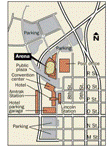Community and Regional Planning Program
Date of this Version
2023
Citation
AJPM Focus. 2023 Jun 13 : 100122. doi: 10.1016/j.focus.2023.100122 [Epub ahead of print]
- PMCID:PMC10260261
Abstract
Highlights : Disparities in distances people traveled for vaccinations by demographics exist. Males and White people traveled longer distances for vaccination appointments. Travel distances of over 10 miles for vaccination likely required motorized transportation.
Introduction: Understanding spatial and temporal trends in travel for COVID-19 vaccinations by key demographic characteristics (i.e., gender, race, age) is important for ensuring equitable access to and increasing distribution efficiency of vaccines and other health services. The aim of this study is to examine trends in travel distance for COVID-19 vaccinations over the course of the vaccination rollout in North Carolina.
Methods: Data were collected using electronic medical records of individuals who had first- or single-dose COVID-19 vaccination appointments through UNC Health between December 15, 2020, and August 31, 2021 (N = 204,718). Travel distances to appointments were calculated using the Euclidean distance from individuals’ home ZIP code centroids to clinic addresses. Descriptive statistics and multivariable regression models with individuals’ home ZIP codes incorporated as fixed effects were used to examine differences in travel distances by gender, race, and age.
Results: Males and White individuals traveled significantly farther for vaccination appointments throughout the vaccination rollout. On average, females traveled 14. 4 miles, 3.5% shorter distances than males; Black individuals traveled 13.6 miles, 10.0% shorter distances than White individuals; and people aged 65 and older traveled 14.5 miles, 2.6% longer distances than younger people living in the same ZIP code.
Conclusions: Controlling for socioeconomic status and spatial proximity to vaccination clinics at the ZIP code level, males and White individuals traveled longer distances for vaccination appointments, demonstrating more ability to travel for vaccinations. Results indicate a need to consider differential ability to travel to vaccinations by key demographic characteristics in COVID-19 vaccination programs and future mass health service delivery efforts.


Comments
This is an open access article under the CC-BY-NC-ND license